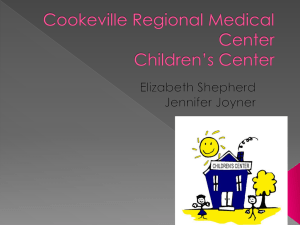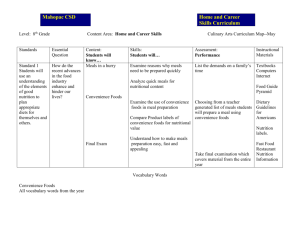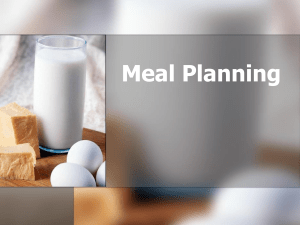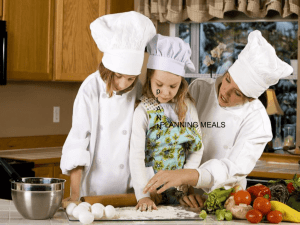Meal Planning A good meal will follow: The American Dietary
advertisement
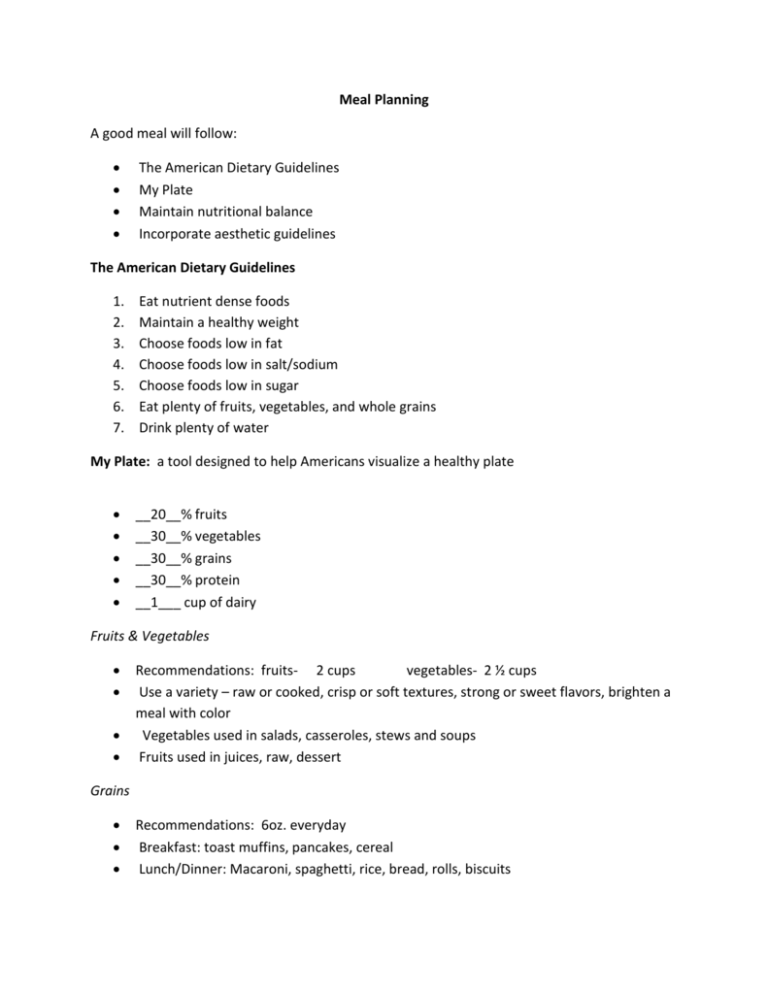
Meal Planning A good meal will follow: The American Dietary Guidelines My Plate Maintain nutritional balance Incorporate aesthetic guidelines The American Dietary Guidelines 1. 2. 3. 4. 5. 6. 7. Eat nutrient dense foods Maintain a healthy weight Choose foods low in fat Choose foods low in salt/sodium Choose foods low in sugar Eat plenty of fruits, vegetables, and whole grains Drink plenty of water My Plate: a tool designed to help Americans visualize a healthy plate __20__% fruits __30__% vegetables __30__% grains __30__% protein __1___ cup of dairy Fruits & Vegetables Recommendations: fruits- 2 cups vegetables- 2 ½ cups Use a variety – raw or cooked, crisp or soft textures, strong or sweet flavors, brighten a meal with color Vegetables used in salads, casseroles, stews and soups Fruits used in juices, raw, dessert Grains Recommendations: 6oz. everyday Breakfast: toast muffins, pancakes, cereal Lunch/Dinner: Macaroni, spaghetti, rice, bread, rolls, biscuits Protein Recommendations: 5 ½ oz everyday Usually appear as the main dish Meats can be found in soups, stews, casseroles, or sandwiches Eggs used in custards and baked goods count as well Dairy Group Recommendations: 3 cups daily Served as a beverage Included in cereals, soups, main dishes, etc Cubed/sliced cheese, ice cream or yogurt What’s wrong with these menus? Breakfast: needs protein and vegetable. All the same color Lunch: lacks dairy group Dinner: no vegetable or fruit – high in fat too! ** Complete What’s missing from these menus? worksheet Nutritional Balance Meals should be planned for nutritional balance, appeal, and suitability to various individual circumstances When planning meals there are 6 things to consider so food is appealing and nutritious Aesthetic Qualities 1. color 2. texture 3. Size and shape 4. flavor 5. temperature 6. Method of preparation Color (some of the most beautiful objects in nature are foods) Many colors of food are available Too many foods of the same color offer no contrast or variation (are dull and boring) Clashing or unpleasant color schemes can make you lose your appetite Texture Can be seen and felt when consuming foods (with the tongue) o Hard, chewy, crunchy, soft, solid, crisp, smooth, sticky, dry, moist, gritty, tough Variety of textures adds interest Common error in planning meals is the lack of variety in texture Size and Shape Size as well as shape of food affects how appetizing food looks Choose foods with various shapes and sizes when planning a meal Avoid serving several foods made of small pieces Avoid too many similar shapes (meatballs, peas, and olives are different colors, but no different shapes – not appealing) Flavor Use a variety of flavors – sweet, sour, bitter, salty (each person has 9000 taste buds!) Smell is also important to tell small differences in flavor Avoid using foods with similar flavors in one meal Temperature Meals are more interesting if some hot and some cold foods are served The temperature outside should be considered when meal planning Hot foods should be served hot and cold foods should be served cold Method of Preparation Meals are more interesting if prepared in a variety of different ways Avoid meals with no main dish or more than one main dish (when planning your menu, start with your main dish, then add courses to compliment that dish) **Complete Aesthetic Qualities worksheet ***Complete
